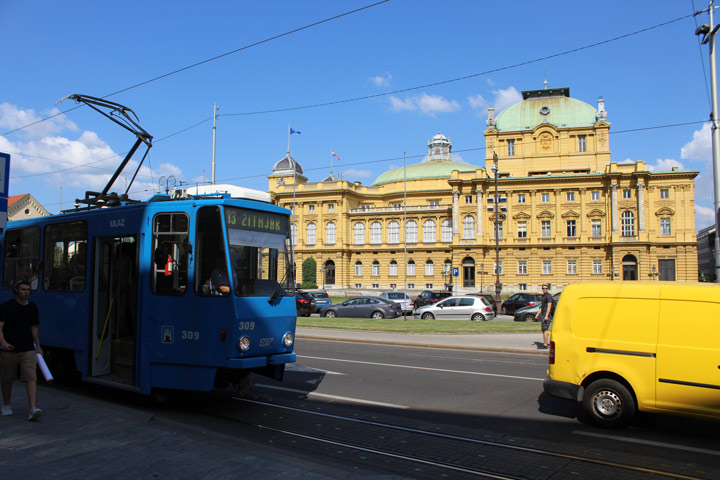Chris & Allyson vs. Italy & Croatia (June-July 2019)
Croatia Day Seven: Slunj, the case of the missing winery, arrival in Zagreb, the Museum of Broken Relationships
At some point in a journey, you can't escape the sinking feeling that it's winding down. Maybe you're not ready to return to regular life. Or maybe fatigue has set in after you've taken your wife on the tourism equivalent of a Russian military retreat for the better part of a week.
Tuesday was set up to be a letdown. We had enjoyed a tiring Monday, we had to spend the day on the road, and we weren't particularly enthusiastic about our destination. Zagreb is billed as Croatia's most "European" city, but we've been to plenty of European cities. We have the refrigerator magnets to prove it, and once a man's refrigerator door has been sated, surely his mind isn't far behind. Nothing jumped out as we flipped through the Zagreb guidebook, and we're not particular fans of traditional European city activities, such as lounging in cafes and complaining about how obese Americans are.
But great players vacation to the final buzzer. Our day started with breakfast in Zrinka's adorable dining room, where she shamed us into packing the sandwiches we failed to make on Monday. Over breakfast, she gave us restaurant tips for Zagreb (which we never used) and warned us about speed traps along the way. She then insisted that we go to Slunj. Once we determined that it was a town and not a Croatian pejorative, we hugged it out with Zrinka and Barbara before hitting the road. They stand out as the finest proprietors in all our travels.
We had barely tasted the wide-open freedom of the D1 when Slunj appeared. A quick synopsis: The river that forms the Plitvice Lakes is the Korana. If you go down the mountain from the lakes, before long the Korana runs into the Slunjcica. Centuries ago, travelers stopped there and tried to settle on the exact spelling and pronunciation of "Slunjcica." It was going to take four or five decades of committee meetings to really nail those answers down, so they built a small town to make the deliberations as comfy as possible. The town is Slunj, and apparently in Croatia you can subdivide a town into villages. The cutest part of Slunj is known as Rastoke; while the highway runs along the top of the river gorge, Rastoke is at the bottom, astride a bunch of waterfalls. Geologically, it's like a mini version of Plitvice Lakes.
In the time it took to read my synopsis, you could have visited all of Rastoke. We parked our car on the side of the highway and walked down a steep local access road, flanked by a giant Asian tour group. It's the kind of town that is made for slow-moving mobs with cameras. It reminded me of the village in "Beauty and the Beast," with mills, houses and restaurants edging over the water. Few people were singing about an anthropomorphic monstrosity abducting the local beauty queen, but in fairness it was early. We had no interest in eating or drinking just yet — we had a moral obligation to eat Zrinka's lunch — so after about 20 minutes, it was back to the car.
And once again, it was back to the wide-open freedom of the D1! Specifically, we were free to drive along at a perfectly reasonable speed, fearful of speed traps, while every angry local passed on the left. We were happy to eventually reach the far more civilized freedom of the A1 — Croatia's version of I-95, which gave us a clear path to Zagreb.
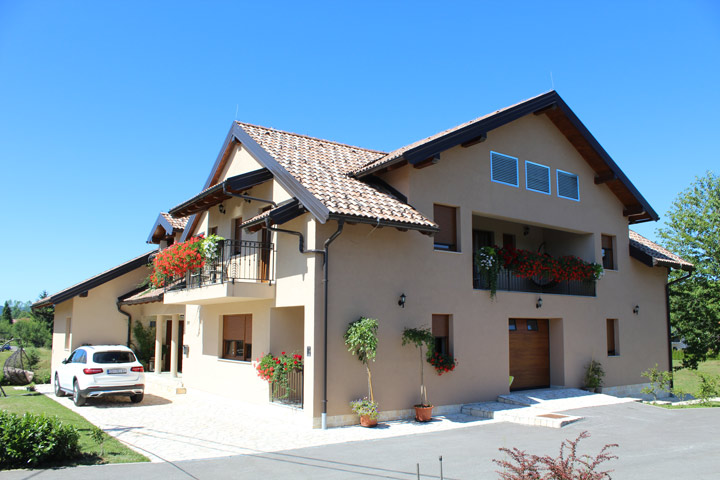
Zrinka House! Our favorite place to stay.
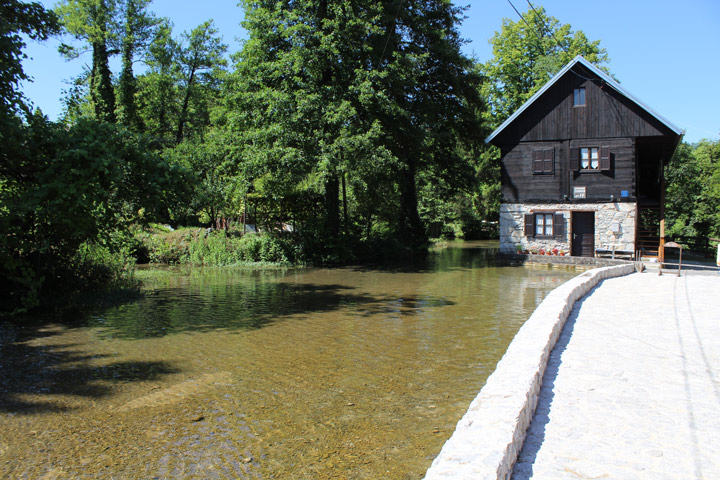
Slunj in all its rustic glory.
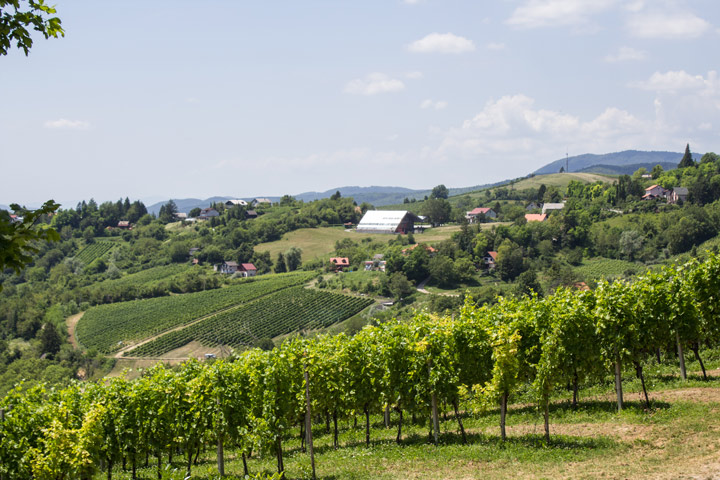
Croatian wine country ... but where are the winos?
But there was no rush to reach another European city, when it was in the vicinity of Croatian wine country. Our first shot at exploring the wine country had been a bit lackluster, but you can't make snap judgements about an entire national wine industry based on one experience. We've been to the wineries of West Virginia, but I'm still willing to give Napa Valley a shot. We should treat Croatia the same. I had found a spot online called Korak Vineyards; it had a decent website and impeccable ratings (4.9 out of 5). The internet said it would be open on a Tuesday afternoon, and it seemed close to the highway. We punched it into the GPS and went for it. There is always honor in the culturally relevant quest for booze. It never implies a drinking problem. Never!
This particular swath of Croatian wine country was stunning. The hills around Zagreb seem to be covered with small family-run farms. Once you leave the highway, the transition to a bohemian rural paradise is mildly stunning. As you climb you're surrounded by trees and lush green vineyards. The views of the valley get increasingly impressive as you climb. The experience is also heightened by the increase in the probability of death by car crash. The roads into wine country are 1.75 lanes wide at best and feature lots of blind turns. We were riding the horn and staying casual on a sleepy Tuesday afternoon, but the persistent threat of head-on collision makes any journey more memorable.
On the way to Korak — a fine Klingon name for a winery — we passed signs for several vineyards and a few buildings that looked like tasting rooms. The GPS directed us to a side road that seemed like a grievous mistake, as it wound past a hilltop cemetery. But we stuck with it, and we were rewarded with a sign for Korak Vineyard! We turned off the road, then parked the car where we thought it should be parked.
What happened next will be hotly debated through the centuries. Was it a failing in us? Did we fall in to a chasm between cultures? Did the Croatian wine industry stumble over its burgeoning potential? Or was something more sinister at play? The facts of the case:
The area was unusually quiet. A cluster of buildings sat near the spot where we parked. None of the nearby buildings had signs indicating that they were a tasting room. Or a visitor center. Or any structure that involved tourists drinking wine. One building was under some kind of construction; it has a big panoramic window facing out on the valley, so we guessed that it was a tasting room in progress.
But no one — not a single person — was around to confirm that analysis. We wandered around the premises; we poked around a little garden; we stood there and looked confused in the time-honored tradition of tourists hoping to be rescued by people who enjoy taking money from tourists. So we wandered a little further, up an unmarked driveway. We passed one half-finished building that reeked like a port-a-john. As we approached the next building, a dog ran out and charged us. No person ran out to collect the dog.
In a movie, this would have been a hostage situation, with international vino-terrorists holding hard-working Croatian grape-stompers at gun point just behind a closed door, demanding their silence until we went away. We knew the winery workers hadn't been Raptured, since surely we would have gone with them. That didn't preclude an alien abduction, but it's hard to see the scientific value of limiting your abductions to Croatian wine country. The weirdness was getting palpable. It was decided to take our dollars to another winery with a less disturbing vibe. We had passed several.
And then things got really weird. At the next winery, there were no people. At the third winery, there were no people. We walked into an unlocked visitor center of some sort — there were other cars in the lot — used the bathroom, and spotted some promotional materials on a nearby table. We walked past empty offices and saw nobody. We retreated to our car, ate our sandwiches and tried to figure out exactly what was happening. With no answers forthcoming, we drove back down the mountain and stopped at one more winery — the one with the biggest road sign we had seen all day. You don't put up a sign like that unless you want slack-jawed Americans to roll up on a Tuesday afternoon expecting wine samples. As we pulled into the lot, we finally saw a person: a woman in a van was pulling out of the lot, and she gave us the kind of look you get from the guy behind the counter at a pizza place that is clearly a money-laundering front for the mob. But once we were in the lot, we saw no people and no signs that the place was open.
This confirmed for us that the entire Croatian wine industry is just a front to launder money, probably for something zany like a human trafficking ring. At that point we had to laugh, because if anyone was watching us and thought we looked concerned, we would have been thrown into the back of that van, moved to a shipping container and spent the rest of our days as sex slaves in an emirate somewhere. A typical European city seemed more appealing than that fate, so we found our way back to the A1, cruised into Zagreb and posted up at the Westin.
Regarding the Westin: "Luxury" is a relative term. In capitalist circles it implies solid gold toilets and gaudy amenities, such as the opportunity to hunt another human being for sport. In communist circles in implies easy access to two-ply toilet paper, and maybe some solidly built furniture to discreetly house government listening devices. Croatia was living between those worlds for a few decades. The Westin isn't quite up to the luxurious standards of its American counterparts, but it ain't bad. It's big, the room was nice enough, and we were high enough up to look out on Zagreb's historic core, about a mile in the distance. We were extremely not tired from all the wine we hadn't sampled, so it seemed like a good idea to sally forth. Most conventional attractions were about to close — it was already the late afternoon — but as we had already narrowly avoided abduction by sex-trafficking oenophile aliens, convention was out the window.

Welcome to Zagreb, Croatia's most "European" city.
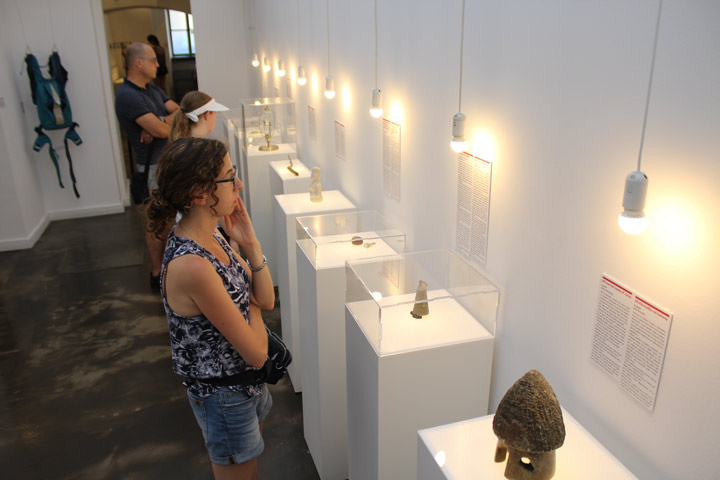
Exploring the Museum of Broken Relationships.
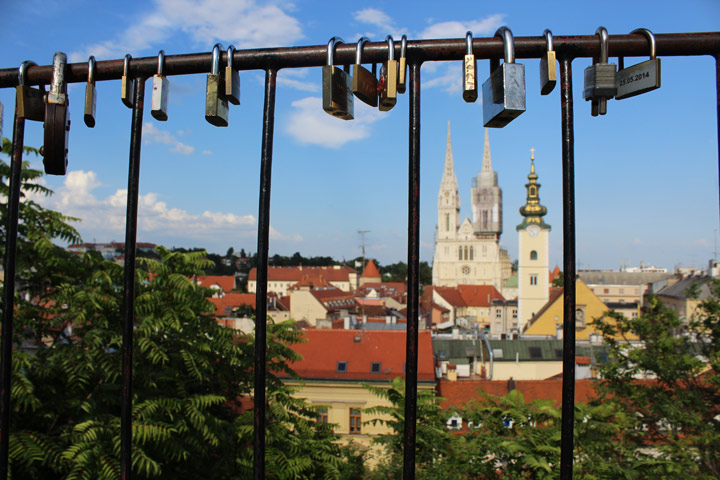
From the upper town, views of Zagreb's biggest church.
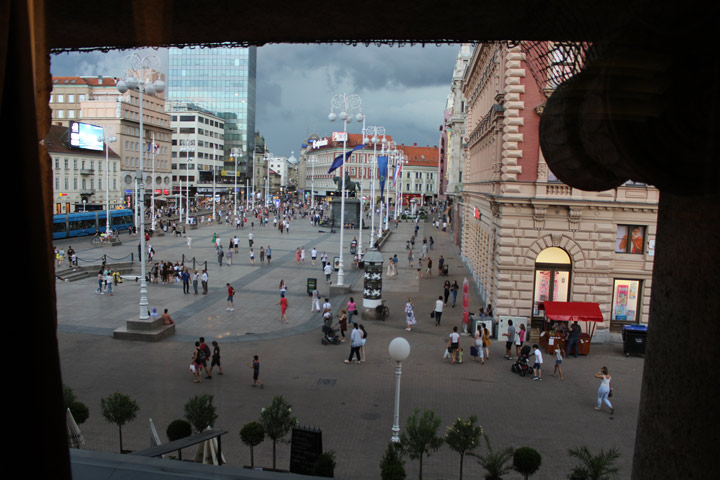
Storm's a comin', maw ... view of the main square from Johann Franck's.
Our destination was the Museum of Broken Relationships, which was open until 11. It was also the one thing in Zagreb that my wife had identified as interesting. A lesser man would have agonized over what this meant. As a confident, anal-retentive man, I agonized over how to get there. Croatia's most European city has the usual weekday traffic, tram cars, and an overall modern vibe. The core of the city is an "upper town" that backs up on a hillside, and a "lower town" that is surrounded by the "green horseshoe" of parks and cultural buildings. The upper town is mostly government buildings, museums and historic structures. The lower town is spread out a bit, with a bunch of restaurants and cafes. Armed with a map we grabbed at the Westin, I thought I could get us to the museum in the upper town — but I didn't quite grasp the workings of the hill.
As we were climbing the flank of the old town, we came across a tunnel on the side of the hill — more on that later. A short distance into the tunnel, we saw a sign pointing to Artpark — which I could find on the map. It's a tiny park, built on the side of the hill, with a series of terraces and a lot of graffiti. It connects the upper town to the lower town. Allyson thought it seemed a little bit "druggy," and a guide later confirmed that it's where they won't arrest you for being high. It was relatively empty when we were there, so we didn't have to step over any twitching bodies as we climbed the Artpark steps. At the top, we found ourselves at the foot of the upper town, around the corner from the museum.
The Museum of Broken Relationships is not uniquely Croatian, but it's pretty damn fascinating. The collection is donated, and each item includes a short essay or description about how the item illustrates a broken relationship. Some of those relationships are romantic; others are for people who died; others are for parents who left. The funniest was a person breaking up with pizza due to a gluten allergy. Items were donated from around the world, and the girls at the front desk told us they rotate their collection every few years. They have far more than they can display, because all over the world, relationships are shattering like bone china in a tornado, every day.
The big takeaway was that heartbroken people are weird. One donor saved a scab from an ex-boyfriend's road rash. Another gave her wedding dress from a ceremony that never happened, because her fiance was killed in a terrorist attack. Another woman met her significant other tandem jumping; she donated his skydiving rig — because he died in a parachute accident three years later. The stories in the museum were alternately moving and profoundly sad.
Now, after a good 90 minutes contemplating failed relationships, the mind naturally wonders to the faults of your own relationship. It is therefore very important for couples departing the museum to immediately find distractions, before any serious conversations can begin and you wind up with only a Museum of Broken Relationships refrigerator magnet to remember her by. (You'd have to donate it back to the museum, and then you'd have nothing.) We went straight back to the cute little promenade above the Artpark, where vendors were selling snacks, sausages and — most important — alcohol. Tourists are supposed to take photos there, so we obliged as we sipped some drinks and enjoyed a little popcorn, confident in the unassailable foundations of our love. We also took a peek into nearby St. Mark's church, which was very ornate and in no way a catalyst for possible divorce.
Once we were thoroughly ready to move on, we took a foot path down the other side of the hill, heading toward Zagreb's biggest cathedral — which was sadly closed. Nature was also getting ready to close up the outdoors, as the sky was getting ominously dark. We felt like an early dinner wasn't out of the question, especially since wandering the streets of Zagreb in a lightning storm wasn't recommended anywhere in the guidebook.
Convenience led us to Johann Franck's — what appeared to be a very touristy dining experience — on the edge of Zagreb's big central square. It's actually an upscale restaurant and night club operated by Croatia's most popular ... coffee company. This was Croatia's version of their Times Square location, which is why lovers of coffee the world 'round all know the name Johann Franck's, and did not have to look it up on the internet. No java enthusiast can forget the subtle complexity of beans grown on the north slope of whatever 43-consonant-named mountain is closest to Plitvice Lakes. Or maybe those beans are just imported from some other place. The important thing is, Croatia has a coffee company. Our decision to eat indoors was rewarded within minutes, when God started his deep cleanse of Zagreb.
The service was excellent and so was the food; my meticulous notes indicate that I had "some kind of veal cordon bleu thingy." But the meal took an unfortunate turn when Allyson's phone lit up. British Airways, in lieu of an early birthday present, had messaged Allyson that our July 4 flight home was canceled. We could get to London, but they would fly us no further. The reason seemed to be: None of your business.
Considering our countries' special relationship, this was hardly a nice thing to do, especially on America's birthday. Perhaps the United States and the U.K. have a broken relationship. But the ordeal once again proved that the bond between Allyson Jaffe and Chris White is as strong as Johann Franck's breakfast roast. After the requisite garment-rending and teeth-gnashing, we used our phones to divide and conquer. Allyson did her Sons of Liberty impression in handling British Airways customer service, and after we hustled back to the hotel during a break in the storm, I started planning for an impromptu Independence Day in London. We were gloomier than London winter, but by the time we went to bed, we had a flight home on July 5, a reservation at the Hotel Waterloo and tickets for the London Eye.
At the very least, we'd be throwing our stout relationship against the waves of July 3 and celebrating Allyson's birthday with as few distractions as possible. Huzzah.
